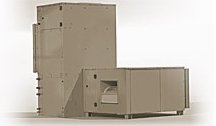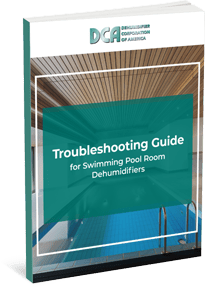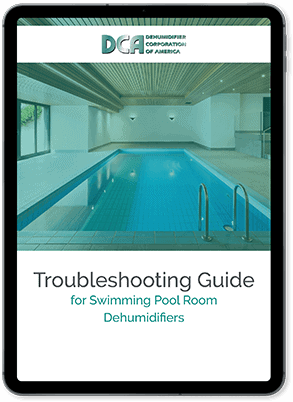Hotel, motel, and residential indoor pool rooms are just a few scenarios where you can find dehumidification systems controlling the relative humidity. An unexpected failure of a dehumidification system in these facilities can have some considerable negative impacts.
 A malfunctioning dehumidification system can cause mold and mildew build up quickly. This can lead to musty smells and poor air quality, not to mention structural issues.
A malfunctioning dehumidification system can cause mold and mildew build up quickly. This can lead to musty smells and poor air quality, not to mention structural issues.
Malfunctioning dehumidification systems can also lead to unhappy customers and bad reviews, which could hurt a business. In an industrial setting, a manufacturer can lose a large amount of money in downtime, missed deadlines, or ruined product when relative humidity is out of control.
Is the Existing System Adequate?
If you continue to experience dehumidification system problems, this is a good time to discuss the topic of continued repairs versus the replacement of the entire system. Dehumidification systems, like all HVAC systems, have a finite service life.
This is also the time to determine if the original dehumidification system was sized properly, installed correctly, and met the original demands of the project. For example, pool water temperature may have been increased in a hospitality setting to meet customer demands. This could lead to the existing system no longer being adequate.
Service Life Considerations
Pool room dehumidification systems, along with dehumidification systems in many industrial applications, operate in harsh environments. The typical service life of a dehumidification system, when sized and installed properly, is approximately eight to twelve years.
One important aspect to consider is if the dehumidifier’s normal service life was compromised, due to faulty system installation. Replacing the failed dehumidifier unit with a new one will not correct the problem and you can expect the same type of issues with the new dehumidifier.
The entire installation, not just the dehumidifier unit, must be analyzed and any problems must be identified and corrected. Ductwork problems causing low air flow through the dehumidifier and erratic power problems are just two areas to consider. Many times, rereading the dehumidifier installation manual will help one’s understanding with what to look for.
Since these systems tend to operate 60 to 70 percent of the time, they depend on a periodic maintenance program for a normal service life. A maintenance program will make sure the return air filters are maintained and all blower belts are tensioned or replaced as needed.
The technician will also run the system through its various modes to determine if the controls are functioning properly. Many times a technician can detect an eminent failure and make the necessary adjustments, before it becomes an expensive proposition.
If pool water chemicals, such as chlorine or bromine, are stored in the same room as the dehumidifier you can expect a shortened service life of not only the dehumidifier but any other metal pool room component, such as pumps and room heating sources.
These chemicals, when in the air stream, react with all metal surfaces, causing oxidation and rusting to occur. Aluminum dehumidifier coils are especially vulnerable to these conditions. Chemicals are best stored in another room in very tightly sealed containers.
Indications of a Failing System
One cue that a system is nearing the end of its useful life is that it goes down and requires more than one service call per year. Continued Freon leaks are another tell-tale sign that components are weakening or that shoddy work had been done. Multiple replacements of the compressor are another indicator that warrants attention. The issue should be analyzed and repaired by a professional before another compressor is installed.
A maintenance program either carried out by an in-house maintenance team or an outside contractor will ensure the longest and least expensive service life of the dehumidification system.
How DCA Can Help
When the time to replace a system is near, DCA can provide a replacement of the dehumidifier, remote condenser, and control system that will get you up and running quickly.
Want to learn more about when it might be time to replace your dehumidifier? Check out our eBook 5 Signs that it’s Time to Replace Your Dehumidifier by clicking here or the link below.
Download Our Guide
5 Signs That It’s Time to Replace Your Dehumidifier
DCA has over 35 years of experience within the dehumidification industry. Maximize the impact of your dehumidifier while minimizing the downtime, hassle, and cost by working with our team of experts.
Contact us today to learn more about our various dehumidifier models and our cost-saving innovations. If you already know what you need, simply submit a request for a quote.






